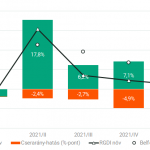Macroeconomics has not done well in recent years: The standard models didn’t predict the Great Recession; and even said it couldn’t happen. After the bubble burst, the models did not predict the full consequences.
The paper traces the failures to the attempts, beginning in the 1970s, to reconcile macro and microeconomics, by making the former adopt the standard competitive micro-models that were under attack even then, from theories of imperfect and asymmetric information, game theory, and behavioral economics.
The paper argues that any theory of deep downturns has to answer these questions: What is the source of the disturbances? Why do seemingly small shocks have such large effects? Why do deep downturns last so long? Why is there such persistence, when we have the same human, physical, and natural resources today as we had before the crisis?
The paper presents a variety of hypotheses which provide answers to these questions, and argues that models based on these alternative assumptions have markedly different policy implications, including large multipliers. It explains why the apparent liquidity trap today is markedly different from that envisioned by Keynes in the Great Depression, and why the Zero Lower Bound is not the central impediment to the effectiveness of monetary policy in restoring the economy to full employment.
Nem található esemény a közeljövőben.
A KRTK Közgazdaság-tudományi Intézet teljesítményéről A KRTK KTI a RePEc/IDEAS rangsorában, amely a világ közgazdaság-tudományi tanszékeit és intézeteit rangsorolja publikációs teljesítményük alapján, a legjobb ... Read More »

Tisztelt Kollégák! Tudományos kutatóként, intézeti vezetőként egész életünkben a kutatói szabadság és felelősség elve vezetett bennünket. Meggyőződésünk, hogy a tudomány csak akkor érhet el ... Read More »

Srí Lanka: a 2022-es gazdasági válság leckéje – A. Krueger Lessons from Sri Lanka Anne O. Krueger Jul 25, 2022 – Project Syndicate ... Read More »

A permanens válság korában élünk – J. Meadway We’re living in an age of permanent crisis – let’s stop planning for a ‘return ... Read More »

A 2021 végén, illetve 2022 elején tapaszalt 6, illetve 7%-os cserearányromlás brutális reáljövedelem-kivonást jelentett a magyar gazdaságból. A külső egyensúly alakulásával foglalkozó elemzések többnyire ... Read More »
